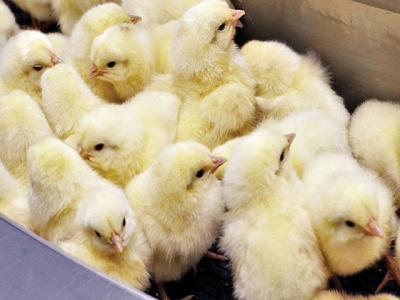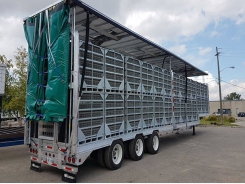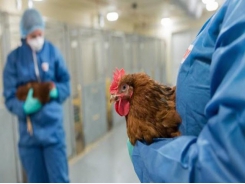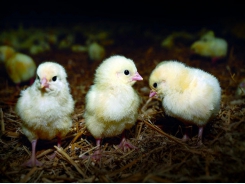9 keys for a successful coccidia vaccination program

Proper coccidia vaccine cycling requires farmers to scrutinize their husbandry and management of chicks and pullets. | Photo by Austin Alonzo
Managing coccidia using a live vaccine requires a different mindset, as well as more intense husbandry, than using a chemical-based program.
Coccidia is a nuisance that’s both pervasive in broiler houses and difficult to control in antibiotic-free operations. Vaccination is a key tool against the disease, but its effectiveness depends on proper administration and management.
On March 13, 2018, Dr. Audrey McElroy, a professor and extension specialist focusing on intestinal health at Texas A&M University, spoke about the most important factors involved in vaccinating chicks against coccidiosis and managing cycling into adulthood. McElroy spoke as part of an event on broiler production at the 2018 Midwest Poultry Federation Convention in Minneapolis.
How coccidia vaccination works
Coccidia vaccination typically occurs by spraying a vaccine made with live oocysts of the coccidia pathogen onto chicks in the hatchery. Ideally, it’s a controlled dose administered in equal amounts to all the chicks. Once the chicks are placed in the house for four to seven days, they will shed the oocysts into the environment. The birds will then uptake oocysts from the litter, the birds will be re-infected and shed again in larger numbers. Hopefully, by the third round of ingestion, the animals will gain complete immunity.
McElroy said this process takes the life of the flock. So, in short-lived flocks, total immunity isn’t developing. Nevertheless, the bird is protected from more pathogenic coccidia in the environment by beginning an immune response to the vaccine.
Problems occur when vaccine application is inconsistent, or when some birds get a dose and others don’t. The unvaccinated birds don’t have the immunity, suffer more detrimental disease consequences and develop clinical coccidia or possibly necrotic enteritis.
With that in mind, McElroy offered these nine keys for a successful vaccine program starting in the hatchery and going all the way to the finishing barn.
1. Store and mix vaccine properly
Vaccines contain live oocysts and can’t be frozen. McElroy said if there’s any ice crystals formed, oocysts are destroyed and the vaccine is ineffective.
Along with storage, diluted vaccines must be properly mixed. Sporulated oocysts are dense and will settle to the bottom of the container. If not properly mixed, vaccine be unevenly applied.
2. Ensure spray nozzles are applying evenly
In an automated spraying system, the nozzles are critical. If they are not functioning properly, then birds aren’t getting the vaccine. McElroy said a simple technique to check the sprayer nozzle’s application is to send a box through the sprayer with a piece of paper in it while recording the action in slow motion. Watch the video and see how the spray is applied. Application must be uniform, or as close as possible, to ensure vaccine cycling.
3. Allow the chicks to preen after spraying
Chicks consume the vaccine while preening one another after the application. They must be given at least 15 minutes prior to preen and placed in an area with lighting conditions that will stimulate activity. The vaccines are dyed to encourage preening.
4. Establish the right conditions on the farm before arrival
Birds must be placed in comfortable conditions that are neither too hot nor too cold. Both will stress the chicks and discourage them from feeding. Birds need access to feces so they can cycle the vaccine. Use a stocking density allowing for a good spread of the oocysts in the environment and then uptake.
If density is too high, particularly in the brood chamber, there will likely be excess moisture in the litter which encourages sporulation. If the birds are confined, they can be overwhelmed with oocysts. A single oocysts can replicate tens of thousands of times if given the right conditions. If density is too low, there won’t be enough shedding, or sporulation, and the birds will not uptake uniformly.
5. Give the birds enough time in the brood chamber
Chicks must be in the brooding chamber long enough to shed oocysts and then uptake them again. The initial peak of oocyst output occurs at about four to eight days. However, the birds shouldn’t be allowed to cycle twice because the chamber will then be densely packed with oocysts that will overcome intestinal integrity.
6. Feed the chicks
The chicks need access to feed immediately upon arrival. If feed access is delayed, they’ll suffer from delayed gut development and vaccine cycling as well as an altered gut microbe population. The first week of life is critical for intestinal development and it’s all based on feed access.
Birds need access to supplemental feed for at least nine days to encourage feed uptake. If the birds are used to seeing feed in the feed pans, they’ll eat whatever collects in the pans. So, the supplemental pans must be filled with feed, not litter or feces.
When transitioning from starter to grower feed, avoid switching during peak coccidia cycling. Changing the type of feed, particle size or composition will cause intestinal stress. Additional stress placed on a gut already compromised by the vaccine can cause health problems.
7. Litter management
Litter moisture must be monitored. Wetter litter indicates a higher presence of oocysts and greater cycling, which can be detrimental to intestinal health, as well as an environment encouraging Clostridium growth. McElroy encouraged managing litter rather than cleaning it out entirely because of the beneficial microbiota living in the substrate.
8. Monitor for intestinal changes
Watch for indicators of intestinal health like droppings in the litter. When droppings are loose, fluffy or coated with mucus that indicates there’s an intestinal shift – possibly due to too much coccidia cycling. If growers pay attention to the environment, they can learn a lot about the gut health.
9. Pay attention to the details inside the house
Finally, farmers need to observe other factors in the house to ensure proper vaccine cycling and health. Water lines need to be clean and uniform to prevent microbial changes. House temperatures must be set to avoid either heat or cold stress, as both can affect the microbial population of the gut.
“It’s every piece to the puzzle in terms of basic management and every piece is important,” McElroy said. “Day-to-day management is hopefully how we can have a more successful vaccine program.”
Related news
Tools

Phối trộn thức ăn chăn nuôi

Pha dung dịch thủy canh

Định mức cho tôm ăn

Phối trộn phân bón NPK

Xác định tỷ lệ tôm sống

Chuyển đổi đơn vị phân bón

Xác định công suất sục khí

Chuyển đổi đơn vị tôm

Tính diện tích nhà kính

Tính thể tích ao




 Method to improve E. coli vaccines developed
Method to improve E. coli vaccines developed  Why welfare is integral to good poultry management
Why welfare is integral to good poultry management